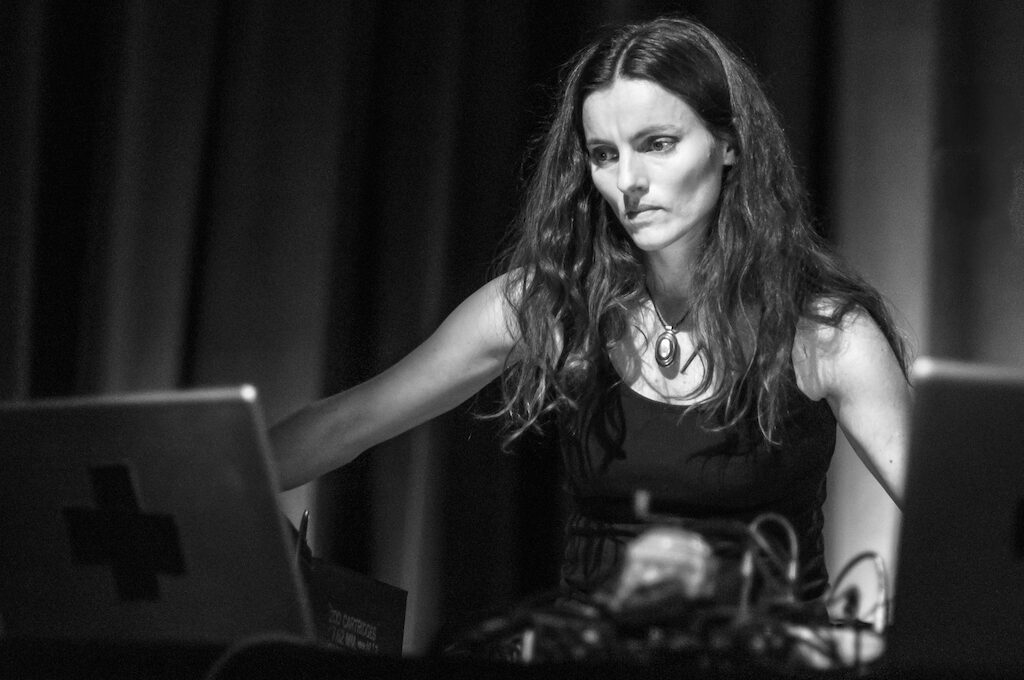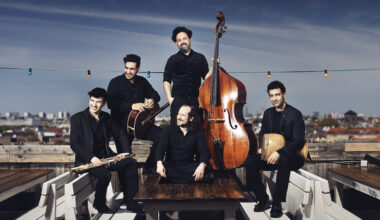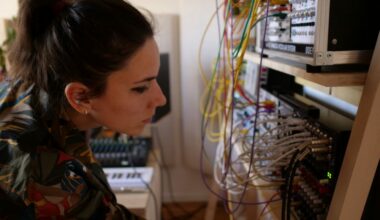Maja Solveig Kjelstrup Ratkje (*1973), composer and performer. She is active as a singer/vocalist, electronics player and studio engineer, as a soloist and in groups such as SPUNK and Avant Joik and in collaborations spanning from orchestras to metal band musicians. She is a member of the Music Section of the Akademie der Künste, Berlin.
Together with Katarina Barruk and Matti Aikio, Maja will present the a new audio-visual work as Avant Joik within the festival Memories in Music at the Akademie der Künste, Berlin.
Avant Joik combines two different ways of working with, thinking and imagining voice. For the Sámi Katarina Barruk, who sings in her native Ume Sámi now protected by UNESCO, images, stories and feelings are the starting point for her evocative joik and improvisations. Maja S. K. Ratkje’s experimental vocal performances, on the other hand, are a result of her practice as an avant-garde voice performer, improvising from the awareness of the voice’s diversity and versatility. Avant Joik – in a new film with the Sámi video artist Matti Aikio – tells in its own poetic way of the injustice to the Sámi, their culture and their ways of knowing and living. Presented as digital format on 7 May at 8 pm.
FACTS
1. The highest form for musical communication is music performed live in the same physical space as the audience.
2. Life has higher resolution than any form for digital art.
3. Computers cannot replace humans.
QUESTIONS
1. What is the biggest inspiration for your music?
Nothing is more inspiring than nature. Our extraordinary existence on an extraordinary planet. A positive force and inspiration for complexity beyond reach. Secondly, imagining the unheard, the unexplored and the absurd. That’s why I love sci-fi and adventures, hiking and climbing too. And modern art because it is multi facetted and doesn’t have one absolute answer to reality. I can be really annoyed by politics as well, so I guess it’s inspiring too, in the sense that it triggers me to include my reaction in some of my works, but art is irresponsible, and I aim my work to raise questions rather than answer them.
2. How and when did you get into making music?
I started hammering on the piano when I could reach the keys, and I used my voice imitating all sorts of sounds around me. Then I played violin and sang in a choir till I turned 14 and started with bands, musicals and punk-country. And eventually modern jazz and contemporary music when I turned 20, immediately followed by free improvisation and noise music. The last years, I’ve even picked up the violin again to play Norwegian traditional music, something I didn’t grow up with. I don’t come from an artist family, so I was allowed to change focus of interest in music as I wished, no one expecting me to eventually make a living out of it, at least not myself. Now I play on all my diversity. I try to see it as an advantage rather than having lost focus.
3. What are 5 of your favourite albums of all time?
From the top of my head:
Lili Boulanger: Du Fond de L’abime, Psaumes 24 & 129, Vielle Prière Bouddhique, Pie Jesu, 3 Pieces Pour Violon Et Piano – EMI Classics 1992
Naked City: Grand Guignol – Avant 1992
Raphael Roginski: Bach Bleach – Multikulti Project 2009
Iannis Xenakis: La Légende DÉer – Montaigne 2002
Togi Hideki: Gagaku Ten, Earth, Sky – Thousand Years of Yuya (google translation from Japanese) – Eastworld
4. What do you associate with Berlin?
Art and space. My friend Ingo J. Biermann who lives in Berlin who made a calm and curious documentary movie about me when my kids were small. The songs by Brecht/Eisler/Weill which I love performing with the trip POING. AdK.
5. What’s your favourite place in your town?
Ah, there are so many! But a year ago when I was in Berlin for the Ultraschall Festival I wandered along on Tempelhof, and it’s so extraordinary to have a space like that in the middle of the large city! I saw some allotment gardens and an office for suggestions for how to use the space. There are really extraordinary possibilities here, that I hope the authorities will take good care of.
6. If there was no music in the world, what would you do instead?
Impossible to imagine! In my opinion all sounds can be music if they are understood as music by the listener. I would be outdoors as much as possible and listen to all sorts of sounds, and people’s speaking voices. Perhaps work with plants.
7. What was the last record/music you bought?
Cowboy Junkies: The Caution Horses (LP), at a second hand vinyl store (how rare is that in Norway now!?) in Hamar, i the inland of Norway where I worked last week at a theatre.
8. Who would you most like to collaborate with?
David Lynch.
9. What was your best gig (as performer or spectator)?
Crepuscular Hour, my hour long work for three choirs, six noise musicians and church organ at Huddersfield Contemporary Music Festival. A blast.
10. How important is technology to your creative process?
A tool that allows me to explore further many of my artistic ideas. By using software when I perform improvised concerts, or by analyzing sounds in studio when I compose. It has been an important part of my understanding of sound and how it works, physically as well as emotionally. I see technology as an extension of my voice when I perform. And a tool to dissect and multiply sound with in studio. I once wrote an essay on feeling cyborgic when performing with all the cables, electricity and controllers, a homage to Donna Haraway’s A Cyborg Manifesto from 1985, that suggests new possibilities for the cyborg as free from categories such as gender, species or machine/flesh. I am currently looking into possibilities of using AI for a new work. We should have come further than the sheer fascination for AI in art, we must use it to say something new about who we are.
11. Do you have siblings and how do they feel about your career/art?
One sister. She wishes me the best.
Photo © Kjetil Valstadsve


